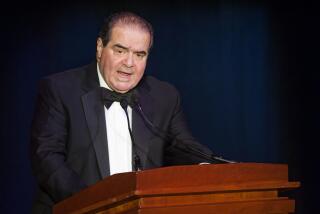Op-Ed: Actually, hate speech is protected speech

Free speech and its limitations are on Americans’ minds. In the past year we’ve seen Nazis and white supremacists rally in our cities, angry protesters chase provocateurs off of college campuses, a comedian wield a bloody effigy of the president’s severed head, and slurs and overt racial animus made a staple of political discourse. Controversial speech has people talking about what restrictions, if any, society can enforce on words we despise.
That inquiry isn’t inherently bad. It’s good for citizens to want to learn more about the contours of our constitutional rights. The dilemma is that the public debate about free speech relies on useless cliches, not on accurate information about the law.
Here are some of the most popular misleading slogans:
“Not all speech is protected. There are limits to free speech.”
This slogan is true, but rarely helpful. The Supreme Court has called the few exceptions to the 1st Amendment “well-defined and narrowly limited.” They include obscenity, defamation, fraud, incitement, true threats and speech integral to already criminal conduct. First Amendment exceptions are not an open-ended category, and the Supreme Court has repeatedly declined to add to them, especially in the last generation. Merely observing that some exceptions exist does not help anyone determine whether particular speech falls into one of those exceptions. It’s a non sequitur.
Imagine you’re bitten by a snake on a hike, and you want to know rather urgently whether the snake is venomous. You describe the snake to your doctor. “Well, not all snakes are venomous,” your doctor responds. Not very helpful, it is?
“You can’t shout ‘fire’ in a crowded theater.”
Almost 100 years ago, Supreme Court Justice Oliver Wendel Holmes, Jr. coined a version of this now-familiar metaphor. Holmes used it to explain why the Supreme Court was upholding the criminal conviction of Charles Shenck, who was jailed merely for distributing materials urging peaceful resistance to the draft in World War I. Fortunately, the Supreme Court — often led by Holmes himself — retreated from this terrible precedent, eventually ruling that speech can’t be punished as “incitement” unless it is intended and likely to provoke imminent lawless action. In other words, this favorite rhetorical apologia for censorship was used in the course of a decision now universally recognized as bad law.
Holmes’ usually misquoted slogan (he said that the law allows us to punish someone for falsely shouting fire in a crowded theater) is really just another way to observe that not all speech is protected and there are limits to 1st Amendment protections. As I said before that’s not in dispute, but invoking the truism does nothing to resolve whether any particular speech falls within the well-defined and narrow exceptions to the 1st Amendment.
“Hate speech is not free speech.”
This popular saying reflects our contempt for bigotry, but it’s not a correct statement of law. There is no general 1st Amendment exception allowing the government to punish “hate speech” that denigrates people based on their identity. Things we call “hate speech” might occasionally fall into an existing 1st Amendment exception: a racist speech might seek to incite imminent violence against a group, or might be reasonably interpreted as an immediate threat to do harm. But “hate speech,” like other ugly types of speech we despise, is broadly protected.
“We must balance free speech and other interests.”
Censorship advocates often tell us we need to balance the freedom of speak with the harm that speech does. This is arguable philosophically, but it is wrong legally. American courts don’t decide whether to protect speech by balancing its harm against its benefit; they ask only if it falls into a specific 1st Amendment exception. As the Supreme Court recently put it, “[t]he First Amendment’s guarantee of free speech does not extend only to categories of speech that survive an ad hoc balancing of relative social costs and benefits. The First Amendment itself reflects a judgment by the American people that the benefits of its restrictions on the Government outweigh the costs.”
“‘Fighting words’ are not protected under the First Amendment.”
Years ago the Supreme Court recognized a very narrow 1st Amendment exception for “fighting words.” If the exception still survives, it’s limited to in-person face-to-face insults directed at a particular person and likely to provoke a violent response from that person. It doesn’t apply broadly to offensive speech, even though it’s often invoked to justify censoring such speech.
“Maybe this speech is protected now, but the law is always changing.”
The Supreme Court’s approach to constitutional rights can change very quickly. For instance, it took less than a generation for the court to reverse course on whether the government could punish gay sex. But for decades the court has been moving towards more vigorous protection of free speech, not less. Some of the most controversial and unpopular speech to come before the court — like videos of animals being tortured, or incendiary Westboro Baptist Church protests at funerals — have yielded solid 8-to-1 majorities in favor of protecting speech. There’s no sign of a growing appetite for censorship on the court.
Even as a free speech advocate and critic of censorship, I’m happy to see a public debate about the limits of free speech. Any debate that raises consciousness about our rights can be productive. But the free speech debate should proceed based on facts and well-established law, not empty rhetoric. Familiarity with our rights and how they work is a civic obligation.
Ken White is a 1st Amendment litigator and criminal defense attorney at Brown White & Osborn LLP in Los Angeles.
Follow the Opinion section on Twitter @latimesopinion or Facebook
More to Read
A cure for the common opinion
Get thought-provoking perspectives with our weekly newsletter.
You may occasionally receive promotional content from the Los Angeles Times.










